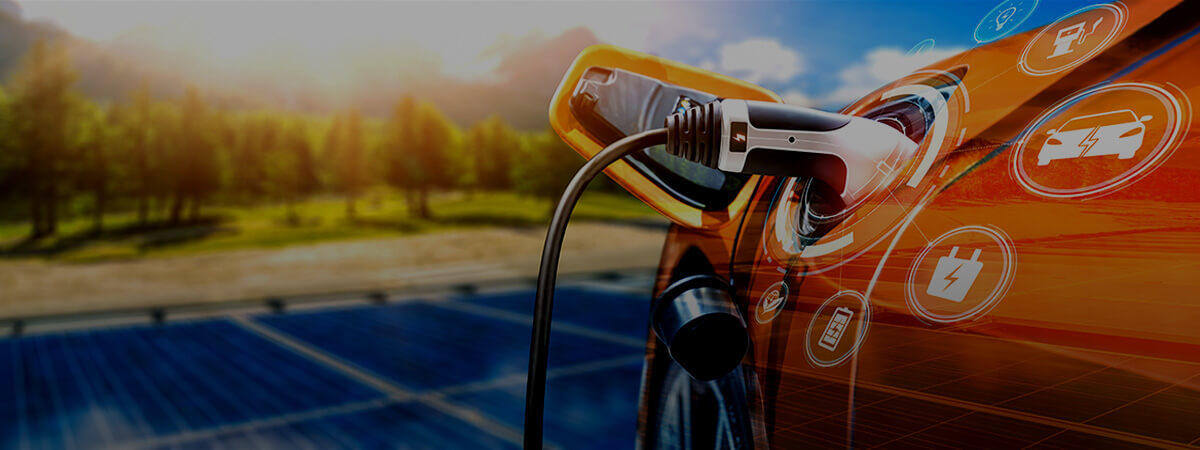
Fueling our EV Future
From intelligent roadways that reduce accidents to air purifying systems for healthier homes and buildings, technology continues to offer the potential for new and exciting developments that make lives safer and more enjoyable. As the challenges presented by climate change persist, sustainability is a core foundation for all of these developments.
One way to make these solutions more sustainable is to leverage rechargeable battery technology, which can be charged by other green solutions such as solar panels. The drive to leverage technology to create a better world for all, and the need to power these solutions sustainably, push our teams at Panasonic to innovate with one aim: Continuing to build the next generation of the world’s safest, highest quality battery cells.
The road of innovation
Panasonic introduced its first rechargeable Lithium Ion (Li-Ion) battery in 1994 and quickly began moving the technology forward. With each milestone in energy density, it seemed like we found the limit. Then we pushed our material science and manufacturing techniques further. We understand that there is no “perfect cell” – there is only “what’s next.” This commitment to continual development led Tesla to select Panasonic as its EV cell supplier in 2012. Today, Panasonic plays a major role in Tesla’s drive toward bringing compelling mass-market EVs to market.
The pace of our EV cell development and manufacturing from 2012 to today is fast and continues to set the standard. But getting to more than 9.5 billion cells shipped in multiple product lines required solving difficult challenges in many areas.
Pace of manufacturing
To create solutions that ensure the EV market can continue to thrive, we brought more than 300 of our best engineers from Japan to Reno, Nevada. This team was tasked to set up our manufacturing practice, create advanced processes and onboard local workers. Behind these engineers was a collection of special equipment, about 60% of which was designed and built in-house for high-density cell production.
Even with this investment in resources, the reality is that there simply is not enough physical space at our manufacturing facility for all the workers to meet the growing need for EV batteries. To address this challenge and improve the manufacturing pace and quality of cells, it is automation that holds the key. Achieving this is a key component in meeting our broader sustainability goals, especially as developments in battery technology - such as energy density - continue to reinforce batteries as a bedrock for a sustainable future.
Energy density
Today’s cells deliver three times the energy density of our first. Greater density improves product performance, while reducing packaging and material requirements. This achievement represents the combined efforts made by thousands of committed material scientists, engineers and other employees across our organization and in our facility outside of Reno.
“Panasonic has so much experience in the area of cell improvement that we understand the challenges, and know where the manufacturing will become more difficult. We’re bringing material attributes forward that improve strengths and diminish cell weaknesses,” said Shawn Watanabe, Panasonic Corporation.
Environmental issues
The move to EVs is motivated by creating a more sustainable world. Toward that aim, we’re making our cells as environmentally sustainable as possible by eliminating cobalt. The cobalt content of our batteries has been reduced to 5%, down from 100% in 1994. This trajectory sets a goal for Panasonic to lead the industry with cobalt-free Li-Ion cells in 2-3 years.
“We’re not just depleting cobalt and eliminating toxic materials, but increasing capacity, making cells lighter and more stable,” Watanabe said.
Products with higher efficiency and lower cost help automakers achieve consumer EV demands, which can make them more attractive than internal combustion vehicles. This furthers the industry’s positive environmental effects, which are bolstered through other efforts such as recycling materials back into our supply chain. For even greater impact, we’re pulling cells and e-waste from other industries around the country.
Automaker needs
One challenge facing the auto industry in regard to EV adoption is addressing the needs of everyday drivers – not just early adopters or tech aficionados. This means offering multiple form factors that align with how we choose cars and trucks today. Our automotive clients tell us that not all buyers want, need or can afford an EV with 400 or 500 miles (645 or 800 km) of range.
To address these demands, we are continually developing new cell pack designs to address the cost- performance-reliability equation. We know, though, that our greatest contribution is pushing energy density forward to give automakers the flexibility to build vehicles with the performance people want, at the cost they can afford.
EV cells powered by passion
At Panasonic, impossible challenges fuel our dedication. By developing higher and higher Li-Ion cell density, we’re helping to accelerate the EV market, and bring more sustainable living to all.
Want to learn more about our developments in sustainability and battery technologies? Check out Panasonic at CES 2022!